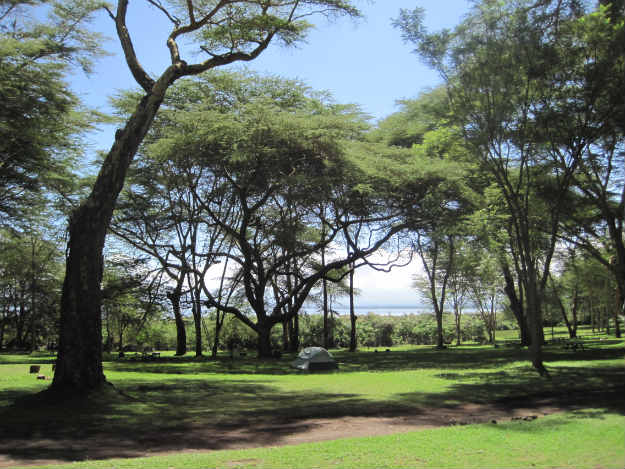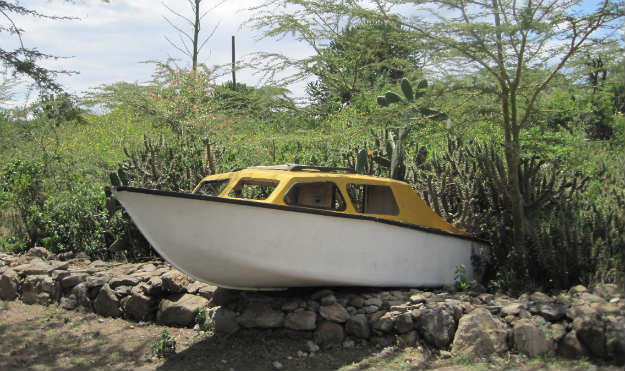
If I had arrived at Fisherman’s Camp self-sufficient with all my camping stuff, I would just have to pay a 500 shilling (US$1 = 80 shillings) camping fee. As it is, I am renting a tent (250), foam mattress (150) and blanket (100) for 500, so I’m paying 1000 total per day. I’m wasting 500 shillings a day, it can be argued, but when I think of traveling with a tent, sleeping bag and bedroll, the weight, the bulk, the pain of cramming your giant backpack into already-crammed buses and the intangible of being light, I don’t mind paying extra. I didn’t expect to camp as many days as I did, but it’s still a trade I make gladly.
Same goes with big hiking boots. Don’t bring camping stuff or boots if traveling in warm weather places unless it is the main thing you are doing on your trip or you intend to camp often or you can store them at a friend’s to greatly minimize lugging the stuff around. I yap about this on the baggage section of my website. I gave away some clothes and mailed a kilo of papers and small souvenir junk home to get lighter. I found a place to store my giant stash of Somaliland money, and I can ride local buses with my bag on my lap if need be.
A big question for me about camping is where to hide my valuables. Here, there are no lockers, no safeboxes, and the staff just parrot how safe the campsite is, that there are guards 24/7, blah blah blah, which is just nonsense they think you want to hear. The better gauge is the sign that says “YOU ARE HERE ENTIRELY AT YOUR OWN RISK.” I did the only thing I could think of doing: padlock the zippers of my backpack to my tent, so someone would have to slash both the tent and bag to get anything inside. Not much of a deterrent, but so far, so good.
All of this said, I’m not much of a camper, much to my regret, and when I travel I am almost always on long, open-ended trips.
Do you have different ideas/suggestions about this?

TheDromomaniac.com
The science & philosophy of one-way travel

Suggestion? Yes: go to Hawaii. It will make you a camping convert as you need next to nothing at all.
travelled with tent and a light sleeping-slip (rarely a matter of warmth in africa, and if it was I wore layers to bed). If I’d known all the details of my 6 month stay ahead of time I probably wouldn’t have taken a tent. Still having one was a great feeling of security that I COULD, in the worst case, stay outside and not in the open, and a couple times it allowed for staying overnight in places that would be extremely expensive without a tent (Hell’s gate is a prime example, and waking up inside the park with animals roaming around was something I’ll never forget). So I might not have carried it if I knew every detail, but I don’t regret it at all.
That said, carrying an SLR camera with lenses, computer, etc, I was already outside the possibility of using a day-pack, so I didn’t mind a few extra things. If I had to choose between using a daypack OR taking a tent and sleeping, I’d choose the former without a doubt.
Thanks, Caleb and Betty!
I always carry my one-person superlight (1 kg) tent with me and a sleeping bag (1 kg) and I really hate how big my backpack is but I do trekking quite a lot when I travel. If I am not going to camp for a while (at least not regularly), I ditch the mat and then buy a new one when I am planning to camp often again. Actually my mat is usually one of those floor puzzles that kids play with – they are essentially mats and they are found in every toy store and they can be very cheap.
I recently met a German guy who, instead of a tent, had a hammock that zips up and is waterproof. You don’t need a mat and possibly no sleeping bag, just clothes for the weather you are in. And of course it won’t be very useful in a desert…
Are those mats comfortable enough? They are pretty thin.
How often do you use the tent and sleeping bag?
It really depends how often I use the tent. I am right now in Indonesia and I do quite a bit of hiking but I didn’t use the tent too much. Only for a couple of mountains, where staying overnight was necessary and it is not commercial enough for guides to be “compulsory” (tents are included in the fee you pay) as on Bali and Lombok (although I am still thinking about trying to do Agung and Rinjani independently). I tried camping a couple of times at the start of trails (so I can start hiking at night to reach the top for sunrise) but then the villagers always found me and insisted on hosting me. That was on Flores, so probably not the case in the more commercial areas.
However, I camped for 8 nights on a small beautiful island called Kanawa in Indonesia, where there is a resort and it was cheaper if you bring your own tent of course. Now I am planning to drive a scooter around Bali and will probably be able to camp on a beach here and there, although for sleeping on the beach outside of rainy season, a mosquito net might be enough 🙂
For some countries tents are a lot more useful than for others. Scandinavia (with the “every man’s right” of camping for free), Iceland, New Zealand (of the places I’ve been) are super safe and it brings down your costs considerably. For other hiking destinations like Nepal, a tent is unnecessary. Last year I travelled by bicycle in South America and did a lot of camping. But if someone is travelling mostly to cities and looking to party, then a tent is useless. However, Singapore begs to differ:
http://www.thestar.com.my/Travel/Asia/2013/09/30/Camping-in-the-concrete-jungle-of-Singapore/
although you might need earplugs (and possibly also blindfolds :P):
http://www2.tnp.sg/content/singapore%E2%80%99s-new-%E2%80%9Csexual-camping-ground%E2%80%9D
Very important: tents cannot go as hand luggage because of the pegs and poles. But if carrying camping gear, one might have to check in a bag because of its size anyway.
About the mats: yes, those floor puzzles are not that thick and soft, but they are very similar to some cheap foam camping mats. An inflatable mat is the best, but it is heavier to carry around. For Iceland (and other cold places) I always use an inflatable because it is essential to keep you insulated from the cold ground. That is actually the main reason why you need a mat at all. I get used to sleeping on hard surface after a night. If there is grass, I sometimes pick some and put under the tent to make it softer. Or I spread the clothes I am not using under the mat. When camping on sand, a mat is unnecessary.
I sometimes use my sleeping bag when staying in hostels where I am not sure when they last changed the sheets. Or when couchsurfing. But that’s probably not enough reason to carry a sleeping bag around for months on end. A sarong or a sleeping bag liner could also do.
And I forgot to add that it is of course always possible to store the camping gear at a hostel, friend or couchsurfer while travelling around, if doing a loop and coming back to the same place. This year I left my camping stuff in Kuala Lumpur and went to Myanmar (with hand luggage only) for a couple of months before coming back to KL. I wasn’t planning to hike in Myanmar and camping is forbidden there anyway.
Kanawa, Indonesia? I was on Flores and never heard of it. Damn.
Thanks for all the tent/camping info. I need to expand my horizons in this area and camp more, but I’ve always been put off by the equipment in weight and size. More power to you that you do it!